Liverpool have left the race for Jude Bellingham, with their focus switching to signing multiple midfielders this summer. So which of their targets suit best?
I want Jude Bellingham. I’m gutted we’re not getting Jude Bellingham. I think we should get Jude Bellingham. I hope we somehow get Jude Bellingham.
But with Liverpool now reportedly out of the race, it seems that the new plan is to sign the impact of Bellingham rather than Bellingham himself.
How might that work?
Smarterscout – an explainer
To answer this, I’ve turned to Smarterscout – an analytics program that uses match data to generate player profiles.
If a player is rated 99 out of 100 in a certain metric, it means the likelihood of another player in the same position outperforming them is 1 percent.
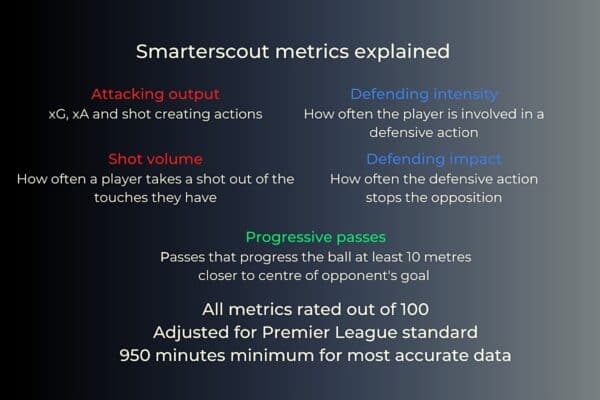
Using Smarterscout, we can look deeper at what a prospective signing brings to the team, how they play and whether they fit what Liverpool need.
Jude Bellingham
Firstly, what does Smarterscout tell us about Bellingham?
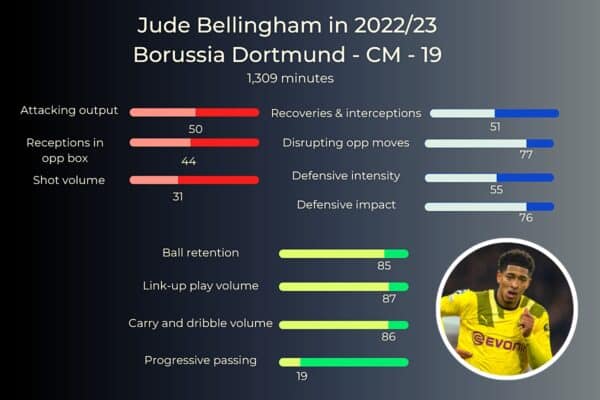
Unsurprisingly, he’s good at everything. He has elite ball retention, defends superbly and offers goal threat.
But he is still one man. Signing Bellingham alone would leave Liverpool incredibly reliant on him to carry the entire midfield department.
So how can Liverpool find the same value in two or three alternative players?
Recreating in the aggregate

Both defensive impact and ball retention have been an issue for Liverpool’s midfield this season.
We’ve talked about intensity out of possession, and Jurgen Klopp has also bemoaned his side’s declining ability to take care of the ball.
Though there are signs of improvement as Klopp unleashes his new system, this season we’ve become a transitional team that’s bad in both transitions.
These are the key areas when considering targets.
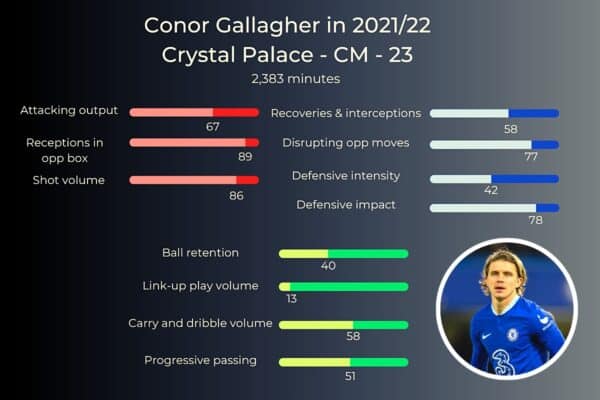
Conor Gallagher hasn’t played enough minutes at Chelsea this season, so this is his profile from his breakout loan at Crystal Palace.
He is a ball-carrier – though he could improve his protection of the ball – and an excellent disrupter of opposition attacks.
Gallagher can also contribute further forward, regularly receiving the ball in the box and creating a high number of shots.
His link-up play is poor, which would present a problem when breaking down low blocks.
But to add mobility, energy and intensity to the midfield, Gallagher is a perfect fit.
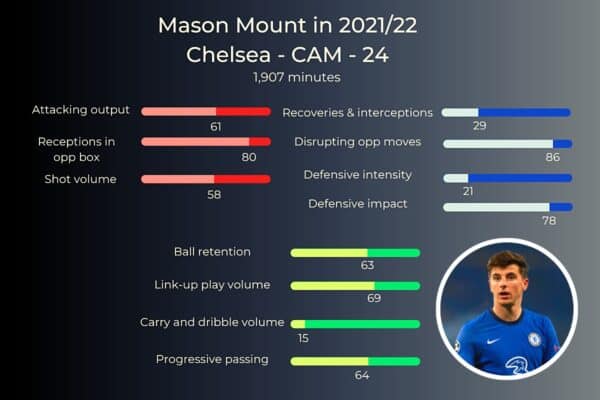
Mason Mount‘s numbers confirm what we’ve seen: he’s a dynamic, creative player, excellent at defending opposition attacks, as well as retaining and progressing the ball.
These numbers are from Mount’s time as a No. 10 rather than a No. 8, which skews the data slightly – we’ve seen him carry the ball much more frequently than his profile suggests – but he’s clearly a superb talent and a strong fit for Liverpool’s midfield box.

Wolves‘ Matheus Nunes has been used in multiple positions under multiple managers, so his data set for central midfield is smaller.
But it’s still clear why we’re keen: he’s an above-average ball-retainer and link player, with a Naby Keita-esque penchant for dribbling.
His relatively low defensive intensity means he’d need coaching in a more aggressive pressing style, though his defensive impact rating suggests he would adapt well.
Nunes’ attacking instincts may need to be curbed to play a more disciplined midfield role in Klopp’s system – though his rocket right boot is a bonus.
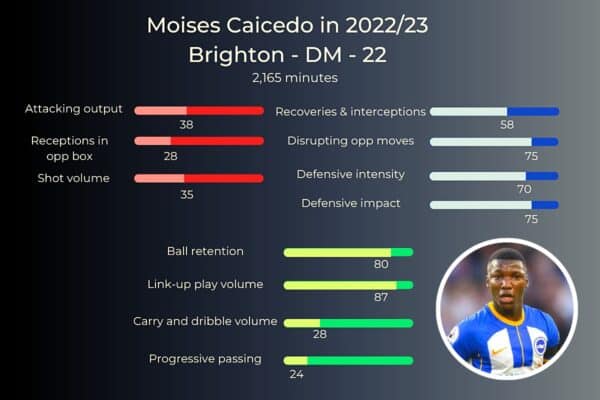
Get excited about Moises Caicedo.
The majority of his minutes have come as a defensive midfielder, but this is a natural home for his gifts.
The Ecuadoran simply does not lose the ball, with an excellent ability to link play for good measure. He’s also a frequent and quality stopper of opposition moves.
His ability to replicate Fabinho‘s passing from deep needs to improve, although if he plays in his familiar double pivot role – possibly alongside an inverted Trent Alexander-Arnold – we know he can break lines of pressure and unleash his creative colleagues.
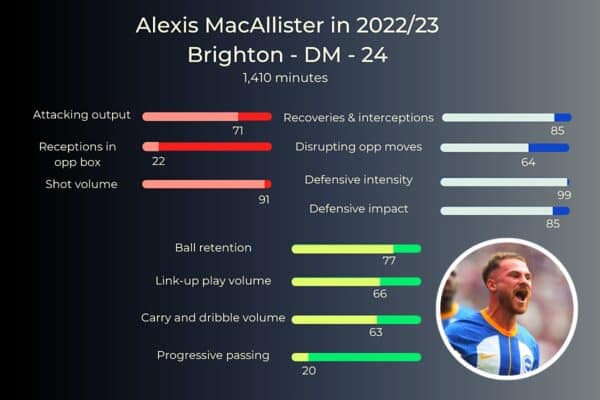
Like Caicedo? You’ll love Alexis Mac Allister.
The second of Brighton‘s double sixes is an elite out-of-possession midfielder who also has fantastic ball retention from both passing and dribbling.
Add in his impressive attacking metrics from a defensive midfield position and the World Cup winner is the only option who might legitimately be a Bellingham upgrade, at least in the numbers.
Combined with the eye test, this makes Mac Allister’s appearance on Liverpool’s radar tremendously exciting.
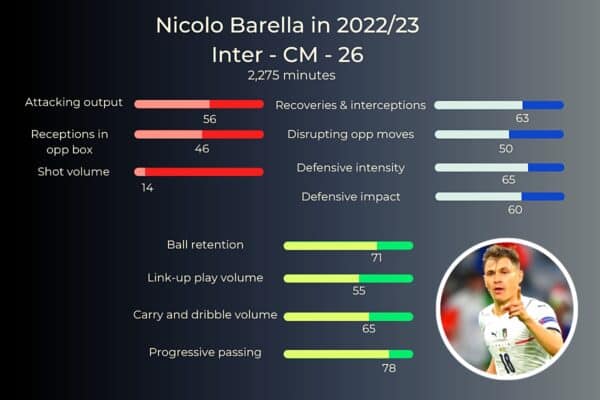
The oldest player on the list, Nicolo Barella has pedigree with several years in the Champions League and a Scudetto from 2021.
Crucially, his ball retention and defensive impact are both above average, while his progressive passing rating is superb.
But there’s something underwhelming about the overall profile considering he’s a joy to watch and theoretically the most proven commodity on the list.
He should succeed at Liverpool, but Barella is probably a weapon in the arsenal rather than a silver bullet.

Former Ajax wonderkid Ryan Gravenberch has struggled to make an impact at Bayern Munich, opening the possibility of a move to Anfield.
With stats from his last season in the Eredivisie adjusted for Premier League standard, we can see that he is a frequent dribbler and link-up player, and his ball retention suggests he’s very good at both.
His defending metrics are only slightly above average, so an adjustment period would be required, while his receptions in the box suggest he’s yet another midfielder who likes to contribute to the attack.
Still a young player and potentially available for a bargain price, Gravenberch would be an excellent mid-term project to complement a more first-team-ready option.
So can Liverpool ‘replace’ Bellingham?

I don’t know enough about football finance or the politics of FSG’s stewardship to know what will happen with Jude Bellingham.
I hope Liverpool find a way to do the deal in the end.
But from a purely sporting perspective, the data shows that it’s possible to replicate Bellingham’s upside with two or three signings – and that the recruitment team have identified the right targets.
Now it’s on the executive branch of the club to get the business done.


